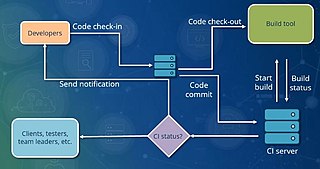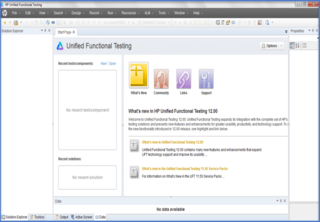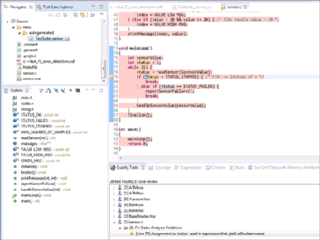Software testing is the act of examining the artifacts and the behavior of the software under test by verification and validation. Software testing can also provide an objective, independent view of the software to allow the business to appreciate and understand the risks of software implementation. Test techniques include, but are not limited to:
In computer programming, unit testing is a software testing method by which individual units of source code—sets of one or more computer program modules together with associated control data, usage procedures, and operating procedures—are tested to determine whether they are fit for use. It is a standard step in development and implementation approaches such as Agile.
Test-driven development (TDD) is a software development process relying on software requirements being converted to test cases before software is fully developed, and tracking all software development by repeatedly testing the software against all test cases. This is as opposed to software being developed first and test cases created later.
In software testing, test automation is the use of software separate from the software being tested to control the execution of tests and the comparison of actual outcomes with predicted outcomes. Test automation can automate some repetitive but necessary tasks in a formalized testing process already in place, or perform additional testing that would be difficult to do manually. Test automation is critical for continuous delivery and continuous testing.

In software engineering, continuous integration (CI) is the practice of merging all developers' working copies to a shared mainline several times a day. Nowadays it is typically implemented in such a way that it triggers an automated build with testing. Grady Booch first proposed the term CI in his 1991 method, although he did not advocate integrating several times a day. Extreme programming (XP) adopted the concept of CI and did advocate integrating more than once per day – perhaps as many as tens of times per day.
Keyword-driven testing, also known as action word based testing, is a software testing methodology suitable for both manual and automated testing. This method separates the documentation of test cases – including both the data and functionality to use – from the prescription of the way the test cases are executed. As a result, it separates the test creation process into two distinct stages: a design and development stage, and an execution stage. The design substage covers the requirement analysis and assessment and the data analysis, definition, and population.
Manual testing is the process of manually testing software for defects. It requires a tester to play the role of an end user where by they use most of the application's features to ensure correct behaviour. To guarantee completeness of testing, the tester often follows a written test plan that leads them through a set of important test cases.

OpenText UFT One, formerly known as Micro Focus Unified Functional Testing and QuickTest Professional (QTP), is software that provides functional and regression test automation for software applications and environments.
There is considerable variety among software testing writers and consultants about what constitutes responsible software testing. Proponents of a context-driven approach consider much of the writing about software testing to be doctrine, while others believe this contradicts the IEEE 829 documentation standard.

TestComplete is a functional automated testing platform developed by SmartBear Software. TestComplete gives testers the ability to create automated tests for Microsoft Windows, Web, Android, and iOS applications. Tests can be recorded, scripted or manually created with keyword driven operations and used for automated playback and error logging.

Parasoft is an independent software vendor specializing in automated software testing and application security with headquarters in Monrovia, California. It was founded in 1987 by four graduates of the California Institute of Technology who planned to commercialize the parallel computing software tools they had been working on for the Caltech Cosmic Cube, which was the first working hypercube computer built.
Test management tools are used to store information on how testing is to be done, plan testing activities and report the status of quality assurance activities. The tools have different approaches to testing and thus have different sets of features. Generally they are used to maintain and plan manual testing, run or gather execution data from automated tests, manage multiple environments and to enter information about found defects. Test management tools offer the prospect of streamlining the testing process and allow quick access to data analysis, collaborative tools and easy communication across multiple project teams. Many test management tools incorporate requirements management capabilities to streamline test case design from the requirements. Tracking of defects and project tasks are done within one application to further simplify the testing.
Continuous testing is the process of executing automated tests as part of the software delivery pipeline to obtain immediate feedback on the business risks associated with a software release candidate. Continuous testing was originally proposed as a way of reducing waiting time for feedback to developers by introducing development environment-triggered tests as well as more traditional developer/tester-triggered tests.

TestLink is a web-based test management system that facilitates software quality assurance. It is developed and maintained by Teamtest. The platform offers support for test cases, test suites, test plans, test projects and user management, as well as various reports and statistics.

Parasoft C/C++test is an integrated set of tools for testing C and C++ source code that software developers use to analyze, test, find defects, and measure the quality and security of their applications. It supports software development practices that are part of development testing, including static code analysis, dynamic code analysis, unit test case generation and execution, code coverage analysis, regression testing, runtime error detection, requirements traceability, and code review. It's a commercial tool that supports operation on Linux, Windows, and Solaris platforms as well as support for on-target embedded testing and cross compilers.

Progress Telerik Test Studio is a Windows-based software test automation tool for web and desktop that supports functional testing, software performance testing, load testing and RESTful API testing developed by Telerik. The tool ships with a plugin for Visual Studio and a standalone app that use the same repositories and file formats. Test Studio supports HTML, AJAX, Silverlight, ASP.NET MVC, JavaScript, WPF, Angular, React, ASP.NET AJAX, ASP.NET Core, and Blazor. Any application that runs on .NET 5, .NET Core, .NET 6 or higher can be automated with Test Studio. Test Studio supports cross-browser testing for Internet Explorer, Firefox, Microsoft Edge, and Chrome.
In software deployment, an environment or tier is a computer system or set of systems in which a computer program or software component is deployed and executed. In simple cases, such as developing and immediately executing a program on the same machine, there may be a single environment, but in industrial use, the development environment and production environment are separated, often with several stages in between. This structured release management process allows phased deployment (rollout), testing, and rollback in case of problems.
This article discusses a set of tactics useful in software testing. It is intended as a comprehensive list of tactical approaches to Software Quality Assurance (more widely colloquially known as Quality Assurance and general application of the test method.

Katalon Platform is an automation testing software tool developed by Katalon, Inc. The software is built on top of the open-source automation frameworks Selenium, Appium with a specialized IDE interface for web, API, mobile and desktop application testing. Its initial release for internal use was in January 2015. Its first public release was in September 2016. In 2018, the software acquired 9% of market penetration for UI test automation, according to The State of Testing 2018 Report by SmartBear.
TestOps refers to the discipline of managing the operational aspects of testing within the software delivery lifecycle.







